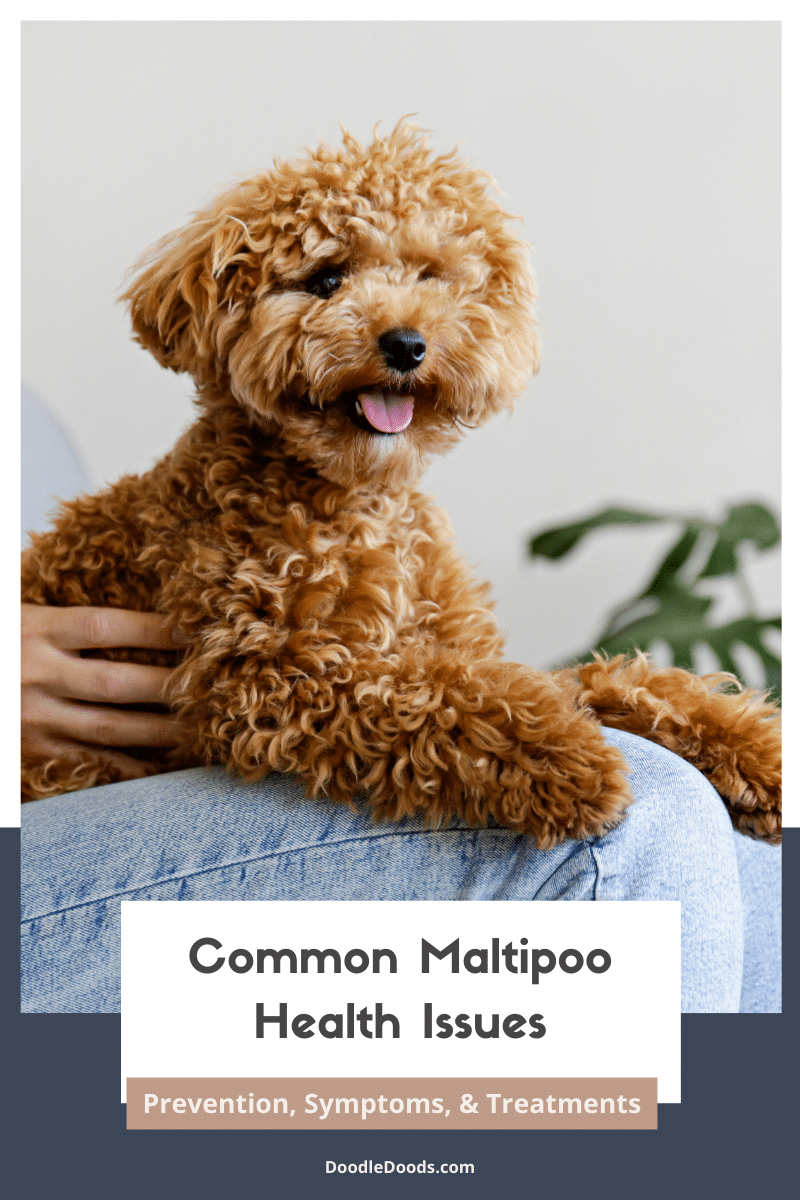If you’re planning to adopt a Maltipoo puppy or already have one of those precious pups in your family, knowing what to expect in terms of their health and wellness is vital. After all, how can you take good care of your dog, if you don’t even know the struggles they may encounter? In this guide, we’re going to discuss the most common Maltipoo health issues that these Doods are prone to, as well as the symptoms to watch out for. Now, this doesn’t necessarily mean that all Maltipoos will have those health conditions at one point or another during their lifetime. However, it’s always good to be prepared for any illnesses, as this will help you provide your pooch the best possible care throughout all of their life stages. Let’s get into it!
Table of Contents
- Common Maltipoo Health Issues: Do Maltipoos Have Health Problems?
- 10 Most Common Maltipoo Health Issues
- How To Prevent Maltipoo Health Issues?
- Common Maltipoo Health Issues: Frequently Asked Questions
- Common Maltipoo Health Issues: Final Thoughts
Common Maltipoo Health Issues: Do Maltipoos Have Health Problems?
The Maltese-Poodle mix is one of the sweetest, most loving fun-sized Doodles out there. They’re tiny, super smart, and come with the fluffiest low-shedding coats. And thanks to their small size, these pups make excellent companions for people who don’t have the biggest houses on the block. Not to mention, you won’t have to worry about having to clean loose dog hair from your furniture and floors. We must admit, the Maltipoo is pretty much the perfect dog!
Maltipoos tend to live long and healthy lives – about 10 to 15 years on average. However, it’s also down to the care you provide for your pup and how they were bred. For instance, reputable Doodle breeders conduct extensive health and genetic testing on their breeding dogs to ensure that the parents don’t carry any genetic conditions that could potentially be passed on to the offspring.
So, do Maltipoos have health problems, then? Well, the great thing about Maltipoos (and other hybrid breeds), is that they often benefit from something called hybrid vigor. This means that hybrid breeds tend to inherit superior qualities from their purebred parents, as their genetic makeup is more diverse. This in turn can minimize the risk of certain health conditions that are more prevalent in their purebred parental breeds. Nonetheless, Maltipoos can still inherit certain genetic health conditions that are common in both the Maltese and Poodle – all of which we’ll discuss in a moment.
10 Most Common Maltipoo Health Issues
So, if you’re ready to take your knowledge to the next level, you don’t want to miss this next part. We’ll cover some of the most common Maltipoo health issues that you should look out for, including the symptoms that come with each of them.
White Shaker Syndrome
One of the most common Maltipoo health issues is white shaker syndrome, or simply shaker syndrome. As the name hints, this condition often manifests in white-colored and small-sized dogs. However, this condition can also be present in larger dogs.
The most common symptoms of white shaker syndrome include:
- Uncontrolled trembling and body spasms
- Loss of balance
- Uncoordinated gait
- Nausea
- Abnormal eye movements
- Seizures
- Disorientation
Although white shaker syndrome may not be as dangerous as some other Maltipoo health problems, it’s still a serious condition that will affect your pup’s overall quality of life. A veterinarian may prescribe a steroid treatment for this condition that can help with tremors. But, as with any medication, there may be some side effects to look out for.
Luxating Patella
Luxating patella, or patellar luxation, is a condition that most commonly occurs in small-sized breeds like the Maltipoo. Patellar luxation means that the kneecap doesn’t stay in its proper place against the femur. If the kneecap becomes dislocated, it can cause pain, lameness, and loss of mobility. It can also lead to arthritis and other joint injuries that can seriously affect a dog’s quality of life.
This Maltipoo health issue is often caused by genetics, but it can also develop due to a trauma or injury. There are various degrees of patellar luxation and the milder cases don’t usually need an invasive medical intervention. However, in more severe cases, the treatment often involves surgery to realign the kneecap so that it stays in place.
Symptoms of luxating patella include:
- Difficulty getting up or lying down
- Difficulty and pain when moving
- Limping, skipping, and hopping
- Hunched lower back
Hip & Elbow Dysplasia
When it comes to Maltipoo health issues, joint problems are something that all pet parents should be wary of. In addition to patellar luxation, these pups are also at risk of hip and elbow dysplasia. While hip dysplasia is more common in larger dogs, elbow dysplasia is more prevalent in smaller-sized pups. However, both issues can happen in dogs of all sizes.
With hip and elbow dysplasia, the ball and socket of the joint essentially don’t fit properly together. This usually happens in early developmental stages, and the joint becomes loose. Instead of the ball and socket gliding properly for optimal movement, they start to grind and cause pain.
Hip and elbow dysplasia are also genetic conditions that are often inherited. That’s why opting for a responsible breeder is crucial, as they carefully screen their breeding dogs for this genetic condition amongst many-many others. However, they can also happen due to injuries and traumas, and even obesity and being underweight can contribute to it.
Depending on the severity of hip and elbow dysplasia, a vet will figure out the best possible treatment plan to manage the pain and discomfort. If the hip and/or elbow dysplasia is in its early stages, simple therapies, such as dietary changes, weight management, certain exercises, and joint supplements, can help manage the issue and slow down the deterioration of the joint. However, in more severe cases, a surgery will likely be necessary.
The most common symptoms of hip and elbow dysplasia are:
- Difficulty getting up or lying down
- Limping, pain, and stiffness
- Difficulty moving around, jumping, and running
- Bunny hopping
- Loss of muscle mass
Tracheal Collapse
Tracheal collapse, also known as collapsed trachea, is a serious condition that affects small-sized breeds, such as the Maltipoo. Trachea is the windpipe that transports oxygen into the lungs. However, if there’s a tracheal collapse, the airway will become tighter and tighter. Consequently, the air and oxygen won’t be able to move as freely into the lungs. And as we know, this can lead to severe health conditions.
It’s not exactly known why some dogs experience collapsed trachea. However, as this condition is more common in small-sized breeds, it likely has something to do with genetics and congenital defects. Another risk factor is being overweight (a common Maltipoo health problem – we’ll discuss that a bit later on), or bad air quality due to use of air fresheners or even smoke.
The most common sign of tracheal collapse is coughing and weezing. This happens more often at night, after eating or drinking water, when you’re picking up your pup, or when they’re excited. In most cases, tracheal collapse can be managed with certain medications that target inflammation and cough. However, your vet may also recommend surgical intervention. Of course, making lifestyle changes are also vital and you should be very mindful about how you handle your pup as to not put any excess pressure on their neck and trachea.
Symptoms indicating to tracheal collapse include:
- Coughing and wheezing, especially when there’s pressure on the neck
- Difficulty breathing
- Vomiting and gagging
- Fainting
Dental Issues
Although dental health problems may not be the most severe of the Maltipoo health issues, they can progress into serious diseases if not treated in a timely manner. In fact, it’s said that the majority of dog breeds develop dental issues during their lifetime, regardless of their breed. That’s why it’s vital that you dedicate your time and energy to your Maltipoo’s dental hygiene routine, such as regular teeth brushing. There are also lots and lots of different dental treats that not only protect your pup’s teeth and gums, but also provide them something yummy to chew on. This is the single most effective thing you can do to prevent dental problems and keep them healthy and happy.
Of course, routine vet visits are also vital, as your veterinarian will also check your dog’s teeth and gums to make sure that they’re healthy. It’s also not uncommon for a veterinarian to suggest having your dog’s teeth professionally cleaned to get rid of any plaque and tartar buildup. If not properly cleaned, these issues could lead to inflammation and infections that could become dangerous.
If you suspect a dental problem, here are the symptoms to look out for:
- Bad breath, also known as halitosis
- Inflamed, swollen, and red gums
- Excessive drooling
- Plaque and tartar
- Pain and difficulty eating dry kibble
- Wobbly or broken teeth
- Bloody saliva
Here you’ll find some of our tried and tested dental care products that can help you take good care of your Maltipoo’s oral health.
Corneal Ulcer
Corneal ulcer, also known as eye ulcer, is a common eye disease in Maltipoos. The cornea is the membrane that sits on top of your pup’s eyeball, essentially protecting the eye from elements and injuries. What’s more, the cornea itself is made up of three layers – the outer layer is called epithelium, the second layer is the stroma, and the inner layer is called Descemet’s membrane. Corneal ulcers can also have various degrees. If only the outer layer has been compromised, the issue usually isn’t as severe. Still, it will require medical care to prevent this from developing into a more serious issue. However, the deeper the injury goes, the more dangerous it will be for your dog.
A corneal ulcer can develop due to various reasons, such as an injury or trauma, or even when certain substances come in contact with your dog’s eyes. Bacterial and viral infections can also contribute to this problem, as well as other eye diseases, such as glaucoma or dry eye.
Signs of corneal ulcer in dogs include:
- Excessive tearing
- Pawing and scratching the eye
- Light sensitivity
- Squinting
- Redness of the eye
- Cloudy eyes
Progressive Retinal Atrophy (PRA)
Progressive retinal atrophy (PRA) is another eye disease that’s common in Maltipoos and other Poodle mixes. PRA is a hereditary condition that’s usually passed on through genetics. That’s why responsible breeders also test their breeding dogs for this disease.
Like many other eye diseases, PRA is progressive in its nature. However, PRA itself isn’t treatable and it can lead to blindness over a few years of time. But what you can do, is to support your dog’s vision with the right diet consisting of ingredients that support eye health, and also supplement with certain vitamins and minerals that your vet recommends. Fortunately, PRA isn’t a painful condition. In addition to that, you can make this condition bearable for your pup by being by their side and guiding their movements, not rearranging the furniture, and not forcing them to walk up and down the stairs.
These are the common signs of PRA in dogs:
- Loss if vision at night
- Anxiety and fearfulness in dark areas
- Dilated pupils
- Cloudy eyes
- Clumsiness
- Decreased eye pigment
- Finally, loss of vision during the day
- Cataracts
Arrhythmia
Arrhythmia is a common heart condition in dogs, including the Maltipoo. This means that dogs affected by this condition have irregular heartbeats. Although it sounds like a scary condition, it’s not always the most dangerous, provided that you keep an eye on your dog’s health and wellbeing with the help of your vet.
In addition to that, irregular heartbeat could also indicate that there’s an underlying health issue to be dealt with. Some health conditions that cause arrhythmia include sinus arrhythmia (more common in brachycephalic breeds), ventricular arrhythmias (common in Boxers and Bulldogs), atrial fibrillation (common in giant breeds), atrioventricular block (usually caused by a congenital defect), and premature beats (caused by electrolyte imbalances or heart disease). Even injuries and infections can cause irregular heartbeats.
One thing to keep in mind, however, is that dogs naturally have faster heartbeats than us humans do. Nonetheless, if you’re ever in doubt, don’t hesitate to reach out to your veterinarian.
Symptoms of arrhythmia in dogs include:
- Very fast or very slow heartbeat
- Fatigue, weakness, and dizziness
- Fainting
- Loss of energy and inability to exercise
- Coughing
- Difficulty breathing
Addison’s Disease
Addison’s disease, or hypoadrenocorticism, is a common Maltipoo health issue that’s often inherited from their Poodle’s side of the lineage. This condition means that a dog’s ability to produce an adequate amount of hormones (mainly the stress hormone cortisol) in the adrenal gland is compromised.
If a dog has been diagnosed with Addison’s disease in a timely manner, it’s very possible for them to live a long and happy life. However, if left untreated, it could ultimately lead to death. It’s not exactly known why some dogs develop Addison’s disease. In some cases, it could be due to genetics, and reputable breeders often test their parent dogs for this condition.
There are many possible symptoms of Addison’s disease, which can make the diagnosis and treatment that much more difficult. Some of the symptoms include:
- Lethargy
- Loss of appetite
- Vomiting
- Diarrhea
- Weight loss
- Hair loss
- Increased urination and thirst
- Irregular heartbeat and weak pulse
- Stomach pain
Obesity
Even though chubby pups are certainly adorable to look at, obesity is not something to take lightly. In fact, obesity can lead to a wide range of other Maltipoo health problems, such as heart disease, diabetes, joint problems, and cancer, to name a few.
Needless to say, obesity is often caused by an improper diet and inadequate exercise. On the other hand, joint problems could also lead to obesity, as a dog can simply be in too much pain to get up and exercise. Similarly, older dogs often develop obesity, as they aren’t as active as they used to.
The easiest thing you can do to prevent your pooch becoming overweight is making sure that they eat the right amount of food each day (don’t forget to keep an eye on those treats, too!), and making sure that they get plenty of exercise each day.
The obvious signs of obesity in Maltipoos include:
- Weight gain – their waistline is more pudgy and you won’t be able to feel their ribs at all
- Decrease in energy levels and unwillingness to exercise
- Harnesses and collars becoming too tight
Maltipoo Health Issues: Other Conditions To Look Out For
In addition to the Maltipoo health problems above, there are also some less severe conditions that these Doods are prone to. Firstly, like their other Doodle cousins and Poodle ancestors, Maltipoos are prone to developing certain allergies, sensitivities, and intolerances. These include food allergies and sensitivities, but also skin sensitivities and allergies. For instance, it’s not uncommon for them to become allergic or sensitive to certain protein sources in their food, the most common of them being chicken.
Additionally, due to their floppy ears, Maltipoos are also at risk of ear infections. To prevent this, we recommend you regularly clean and dry your dog’s ears to prevent any overgrowth of bad bacteria. By the way, trimming the hair inside the ears can also greatly help with that.
How To Prevent Maltipoo Health Issues?
Although the Maltipoo health issues we mentioned above are certainly worrying and require immediate veterinary attention, there are also plenty of ways that you can prevent severe health conditions and complications stemming from them. Let’s take a closer look.
Adopt From A Reputable Breeder
As we’ve already mentioned a couple of times, the best thing you can do to prevent potential Maltipoo health issues is to only adopt from an extremely reputable breeder with a proven track-record. A reputable breeder will follow responsible breeding guidelines, such as extensive health and genetic testing of their breeding dogs to ensure the healthiest litters possible. Now, this doesn’t mean that there’s a zero chance of these pups inheriting any genetic health conditions. However, it does greatly minimize the risks.
Have Your Pet Routinely Checked By A Veterinarian
Needless to say, taking your pup to routine vet checkups is one of the absolute best things you can do to keep them healthy. Not to mention, if caught early, most Maltipoo health issues can be treated or managed before they develop into more serious conditions.
During puppyhood, you’ll likely have to take your pup to the vet more frequently to track their growth and development, to get them fully vaccinated, and for getting them spayed or neutered. Once they reach adulthood, yearly vet checkups should be enough. However, if you notice any worrying signs or symptoms, even if they’re only behavioral, we urge you to take your dog to the vet as soon as possible. And during those golden years, you may have to take your dog to the vet around every six months or so to extend their lifespan and provide them the best care during those final years.
A Regular Dental Hygiene Is Necessary
As we discussed above, dental diseases are rather common in Maltipoos. And the best way to prevent them, of course, is by taking good care of their teeth and gums. We recommend you regularly brush your dog’s teeth to prevent any plaque buildup and tartar. High-quality dental treats can also go a long way! In fact, many dental problems start our as simple issues that will then develop into much more serious conditions over time.
Feed Your Pup A Healthy & Balanced Diet
Feeding your pup the right amount of food is key to a long and healthy life. Firstly, by knowing exactly how much your dog should eat, you’ll be able to prevent obesity and malnourishment. And as we know, both of these issues can lead to a host of other health conditions.
Secondly, high-quality dog food has a balanced nutritional profile and it includes only the best, healthiest ingredients for your pup. You should avoid any unnecessary ingredients, such as artificial preservatives, flavors, and colorants. Not only can these contribute to allergies and sensitivities, but also contribute to other health conditions. Our ultimate guide on the best dog food formulas for Maltipoos has some excellent recommendations that both certified veterinarians and Maltipoo owners swear by.
Don’t Forget Mental & Physical Stimulation!
Last, but not least, it’s vital that you provide lots and lots of daily mental and physical stimulation for your Maltipoo. Daily exercise is crucial for your pup’s weight management, but also their joints, muscle formation, and heart health. Likewise, mental enrichment keeps their brains working, just as they were designed to. After all, they’re intelligent little beings that love to be challenged. By the way, even training counts as mental stimulation, but don’t forget other enrichment methods, such as puzzle games and interactive toys.
Moreover, physical and mental stimulation prevent boredom – the leading cause of destructive behaviors, such as excessive digging, barking, and simply tearing apart your house and furniture. Don’t underestimate it!
Common Maltipoo Health Issues: Frequently Asked Questions
The most common Maltipoo health issues include joint problems like hip and elbow dysplasia or patellar luxation, eye diseases like PRA and corneal ulcer, white shaker syndrome, Addison’s disease, arrhythmia, and obesity. Maltipoos are also at risk of allergies and sensitivities, and also ear infections.
Maltipoos are more prone to tracheal collapse and the most common symptom of that is difficult breathing. Fortunately, this condition can be managed to some extent with certain medications. However, in some cases, surgical intervention may be required.
The average life expectancy of a Maltipoo is around 10 to 15 years.
Well, that’s more of a subjective question, as all breeds have their pros and cons. However, it’s worth noting that Maltipoos can be rather sensitive and they don’t tolerate being left alone for long hours at a time. For this reason, these pups are more suited for people that don’t have to work in the office and can’t have anyone spending time with the pup during the day. Another thing is that Maltipoos can sometimes be a bit vocal.
Not necessarily, no. As long as you do your part by providing your pup the right amount of healthy food, plenty of exercise, proper veterinary care, and lots of kisses and cuddles, your Maltipoo should live a healthy, happy, and fulfilled life.
Common Maltipoo Health Issues: Final Thoughts
Knowing what to expect in terms of Maltipoo health issues is the key to providing your pup a healthy, happy, and fulfilled life for many years to come. We hope this article managed to shed some light onto all the potential health conditions that these little Doods are at risk of, so that you can take the best possible care of your canine pal.
Learn How to Care for Your Doodle Puppy!

Perfect for first-time Doodle parents, get ALL your questions answered, including questions new Doodle parents don’t even think to ask.
Plus, get $700 worth of Bonus Materials for FREE, including:- Doodle Parenthood Community and Support Group ($190 value)
- Doodle Puppy Growth Tracker ($20 value)
- EMERGENCY Cheatsheet: When To Call The Vet Immediately ($50 value)
- HELP! Button ($145 value)
- And SO MUCH MORE!





